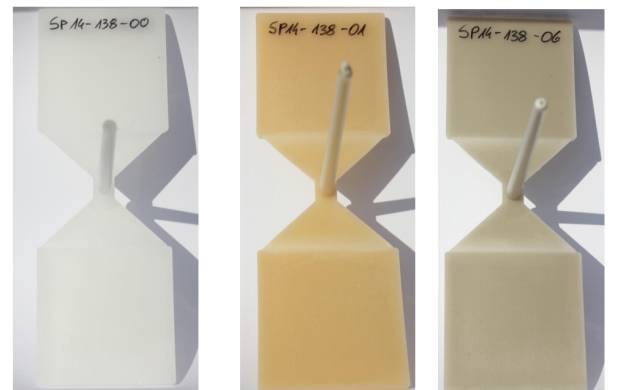
Environmental assessment of bio-fibre reinforced composites during the innovation process – Life cycle analysis and Upscaling
Despite replacing fossil raw material, the environmental performance of bio-based fibre reinforced composites is not per se more valuable-. Resulting from the change in material composition, the manufacturing process needs to be adjusted, such as the injection molding forming process. Detailed analyses and comparisons with reference materials are necessary for the assessment of environmental performance, due to changed requirements for production processes, for material characteristics, as well as for end product and service life.
Material: Cumulative Energy Demand (CED) and Carbon Footprint (CF)
During the development of a new polypropylene (PP) composite material with bio-based fibres, which can be utilized, for example in the automotive sector, different molding compounds were analysed regarding their influence on the production process for the evaluation of environmental performance.
By substituting a share of PP with bio-based fibres, the new composite material has different values in energy intensity (CED in MJ) and in Carbon Footprint (CF in kg/CO2 equivalents) in comparison to neat PP, e.g. -15% MJ/kg and – 20% kg/CO2 equivalents.
Fibre reinforcement results in improved material characteristics, through which further environmental advantages can be achieved. A comparative analysis of these materials with consistent stiffness properties illustrated that the new material saves 30% in CED as well as 35% in CF.
Process: Specific energy demand
Changes in the material composition entail adaptations in the manufacturing process, such as the injection molding process. Firstly,In the laboratory, the energy demand of the injection molding process was analysed for different molding compounds with a matrix of PP and different shares of fossil and bio-based fillers. Thereby, the impact of different filling materials and their share in the composite on the process of injection molding, on the specific energy demand of the process, could be identified.
Following the analysis of the power curves, the cycle times and process phases were determined. The shot weight was used to calculate the specific energy demand [MJ/kg]. The results span between a range of1.7 MJ/kg and 3.2 MJ/kg, whereas the bio-based fibre composites are found in the lower section of the range It was shown that this is achieved by a shortened holding phase, which is especially energy intensive.
Upscaling: Specific energy demand
In addition, three molding compounds were processed on two industrial-scale machines in order to assess the impact of upscaling. Considering the upscaling of shot weight and the resulting necessity to switch to bigger machines, it was shown in three experimental series that the specific energy demand indicated both an increase as well as a decrease in efficiency. On the one hand, savings in cycle time accounted for about 40% of process energy. On the other hand, the switching of technology from all-electric to hydraulic machines resulted in a higher demand of operating power.
Impact and effects
Bio-based fibre composites can be an interesting alternative towards bio-economy: by substituting fossil-based material with renewable material, by saving resources through increased functionality, as well as by saving energy through adapted processing.
In this study, the influence of composite recipe and upscaling of a new bio-based fibre composite on the environmental performance was subject to research in order to provide feedback for further research and development.
It was shown that a differentiated environmental assessment during the process of material development can provide important input.





